The following ‘notes’ were made as different issues came to mind while replaying the talks in class and the presentation. They are not in any hierarchy. All the images on this page are either scoured from the Internet, or are from Studio Libeskind.

Jüdisches Museum, Berlin.Source
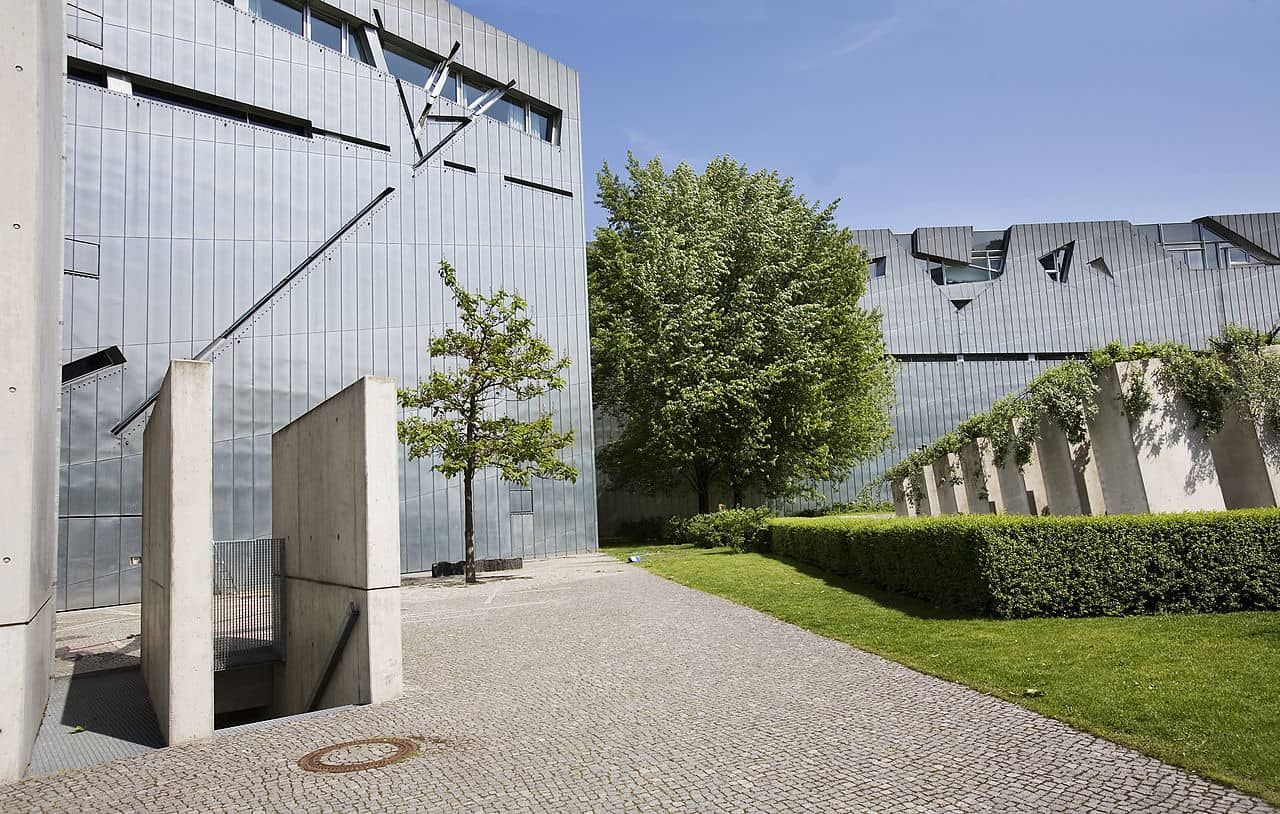
Jüdisches Museum, Berlin.
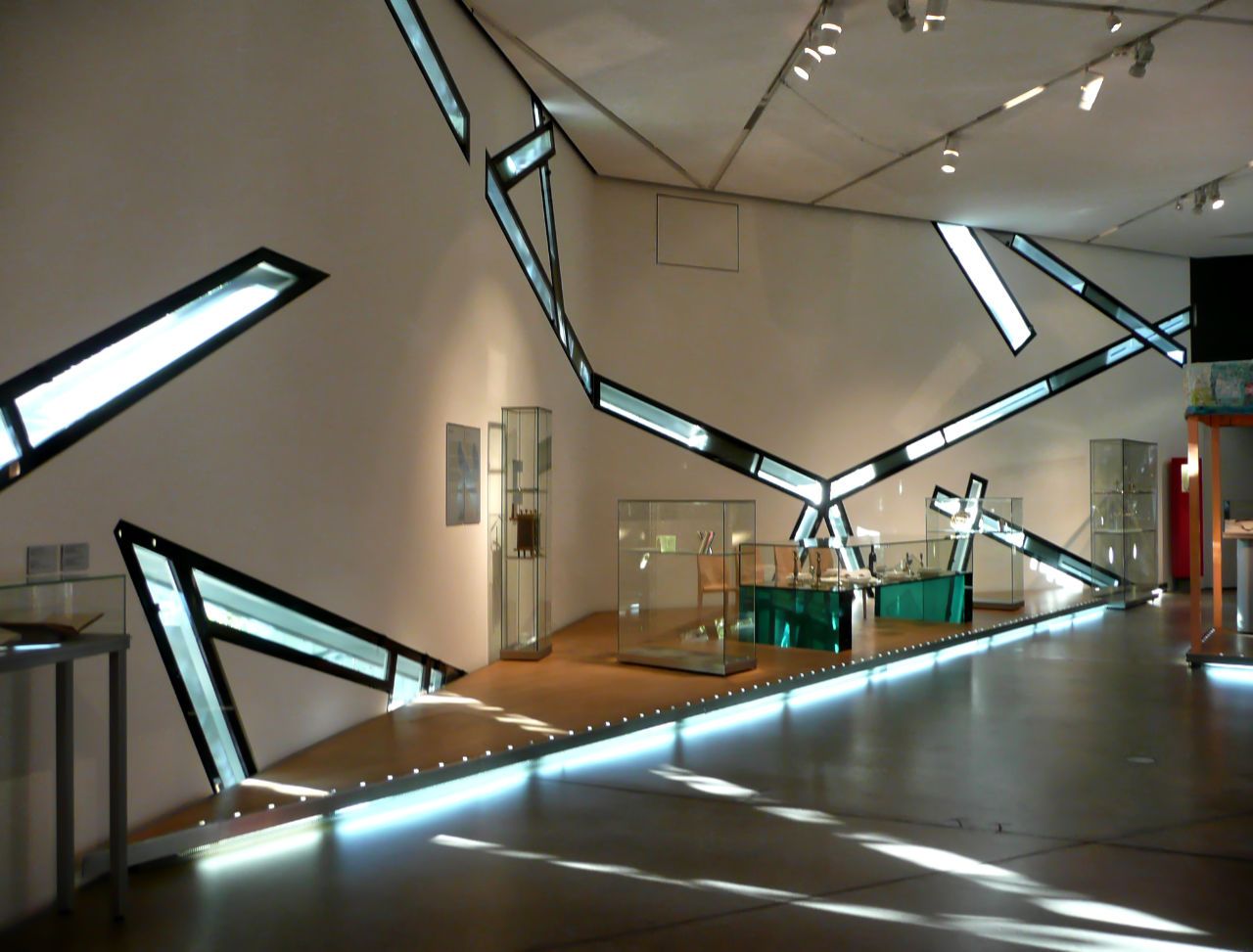
Jewish Museum, Berlin - Interior View. Source
Strength is born of constraint and dies in freedom. Leonardo da Vinci
What is more important, the ‘intention’ or the “effect”? Arguably both are, but in an architectural attitude such as the one consciously adopted by Libeskind, it is necessary to ask whether the work is having the necessary ‘effect’, precipitating into the intended consequences at the social level. This is not to question the architect’s work, but to question the attitude that drives it. At first glance, it does not seem like an architecture of multiple intentions or of multiple effects; not an architecture capable of generating varied images in the mind. There is also the lingering danger of the narrowing down of the range of interpretations spawned due to the “press-release” from the architect.
Is the purpose of architecture to go above and beyond the needs of shelter? Does Libeskind intend the effect akin to that in theatre, or music, or literature? Surely man has lived without literature, whether printed or folklore, in the ages of prehistory. And we have lived without architecture. Of all the living, man has his mental energy vastly in excess of his need, which urges him to work in various modes of creation for its own sake. As if like God, he takes pleasure in productions that are unnecessary to him, and therefore, an extravagance and not the poverty of his hand-to-mouth existence. Art reveals man’s “wealth’. It is an expression of excess, an end in itself.
Architecture has its vital organs, like our body, that are important in maintaining its efficiency, but its skin is not a mere sac to hold the living quarters and the services. It is an image —its highest value is in the fact that it communicates its personality. It has shape, color, and movement of light, movement of man and other objects in it. Most of these attributes belong to the realm of ‘excess’ that are needed only for expression, and not for the “preservation” of man. This excess is dominated by our imagination. This excess also stimulates the sense of our existence. The intention at the Jewish Museum has been to re-expose the reality of the objects, ideas and beliefs we have surrounded ourselves with, and in the ‘mundaneness’ of our daily existence have taken their value or brilliance (better still, notoriety) for granted. Very much like poetry.
It impresses upon the participants the notion that you cannot avoid the apocalypse, impresses upon them the impossibility of saying: I’ve already been there, already seen it. Daniel Libeskind
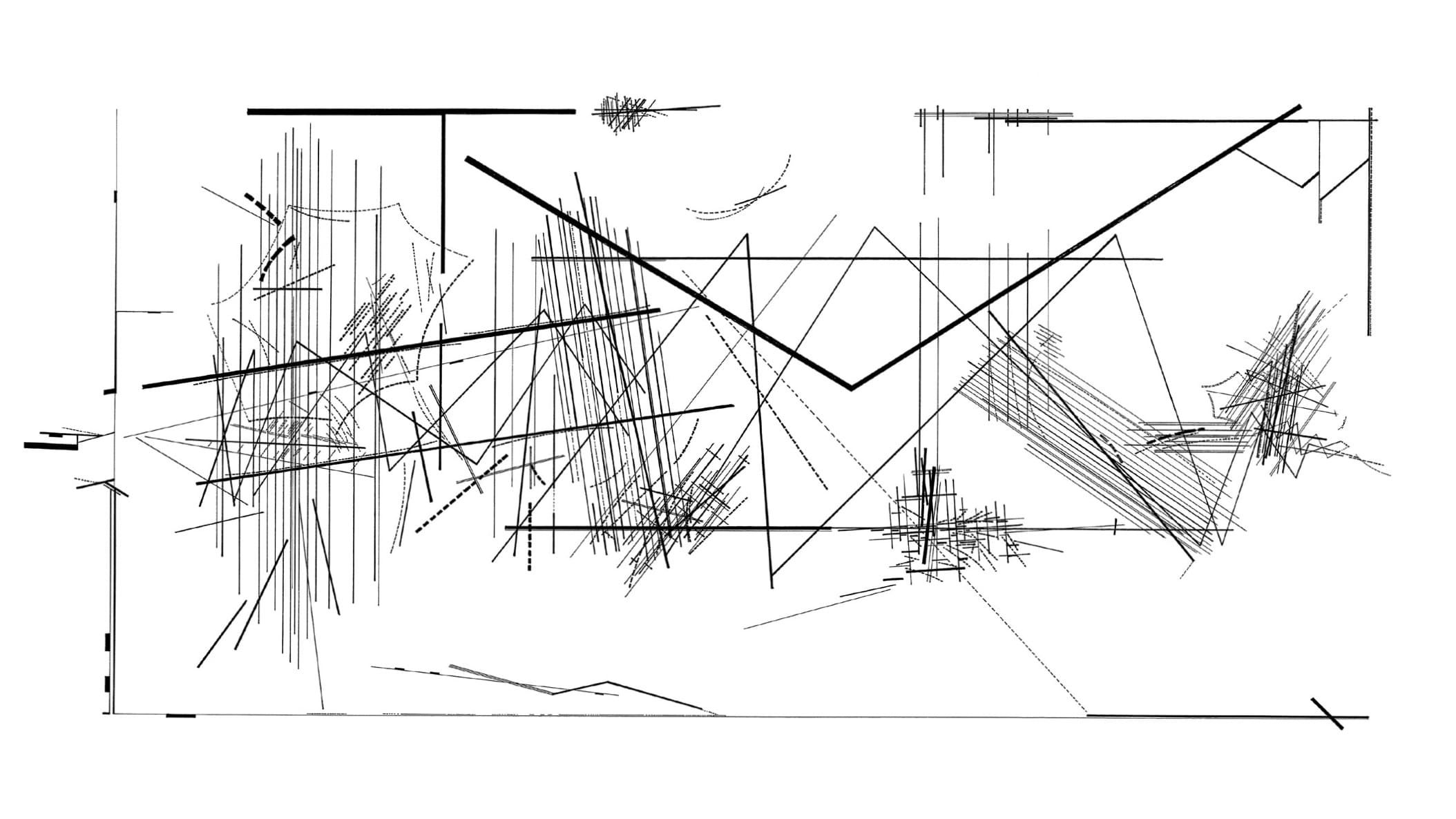
Chamber Works. Drawing from the Architect’s website.
Muller says that ‘Daniel Libeskind’s drawings and architecture reveal a lack of measure, the hubris of the belief in the constructability of the world’. Traditionally, the task of the interpreter/critic has been defined as to delve into/ uncover/ disclose/ reveal/ divulge/ discover/ unfold/ show what lies hidden/ unseen/ ‘beneath the surface’ or ‘behind the curtain’. We may also ask what lies beside/ above/ below/ and in front of the object. When a critic talks about an object, he faces the object. The object becomes a frontage or façade, a signifier of what it stands in front of.
This posture assumes that a ‘meaning’ is assured, that it exists, established by the fact that the object is facing us; that there is an accessible reality offering evidence of previous events that can only be recovered through it. So, the present becomes a façade of history whose fact of existence permits an access to the past, to origins, essences, intentions, motives, or causes. Objects that cannot be thought of in these terms resist interpretation since, no clue has been offered as to where we should stand, or what we should look toward.

Chamber Works. Drawing from the Architect’s website.
In ‘Chamber Works’, the network of lines creates signs that reference nothing. Behind the lines, nothing is visible—no force, velocity, intent, or frame of mind of the creator at the instance of their drawing. An approach that would lead through the lines to the event of their being made is denied us. The denial is perpetual, however much we may shift our position with respect to them. They are remote and opaque even to their author. Even Libeskind claims no authority in regard to his own work. There is a near total disengagement from signification of any kind. While from a conventional distance the effect of the lines in Chamber Works is of ‘staid politeness’, a closer inspection reveals the ‘demonic energy’ within them. In it is a violation of all the interpretative norms of our mind. The slashing lines that scud across the exterior of the Jewish museum are similar to those in Chamber Works, in the sense that they deny us the rationale of the internal function and the constructional logic of the building. Gestures of form and pattern appear like the product of a mathematical formula, especially because of the architect’s inclination towards that subject. But he does not expose his ‘compositional process’ to scrutiny. The code seems knowable, but the design is disturbing since its sources remain unrevealed. The violation of incomprehension that is experienced here is similar to the violence of amnesia that we feel when confronted with reliving memories. We, as the grandchildren of WWII, find ourselves inadequate to re-live the Holocaust. Our imagination fails us in recreating the tragedy of that event. From this void/impasse of the imagination, a horror develops: and this horror takes the place of the original.

Jewish Museum, Berlin - Plan. Drawing from the Architect’s website.

Jewish Museum, Berlin - Elevation Drawing. From the Architect’s website.
Phillipe Starck speaks of “fertile surprises” when discussing the emotional power of his works, which he calls “emotive products”. The same can be said of the works of Daniel Libeskind, at least as far as the role/function of the work is concerned. The intention in all above cases is to turn the people from mere spectators to actors, or participants. This attitude arises from the disappointment (bordering on impatience) with the apathy of the people towards their environment.
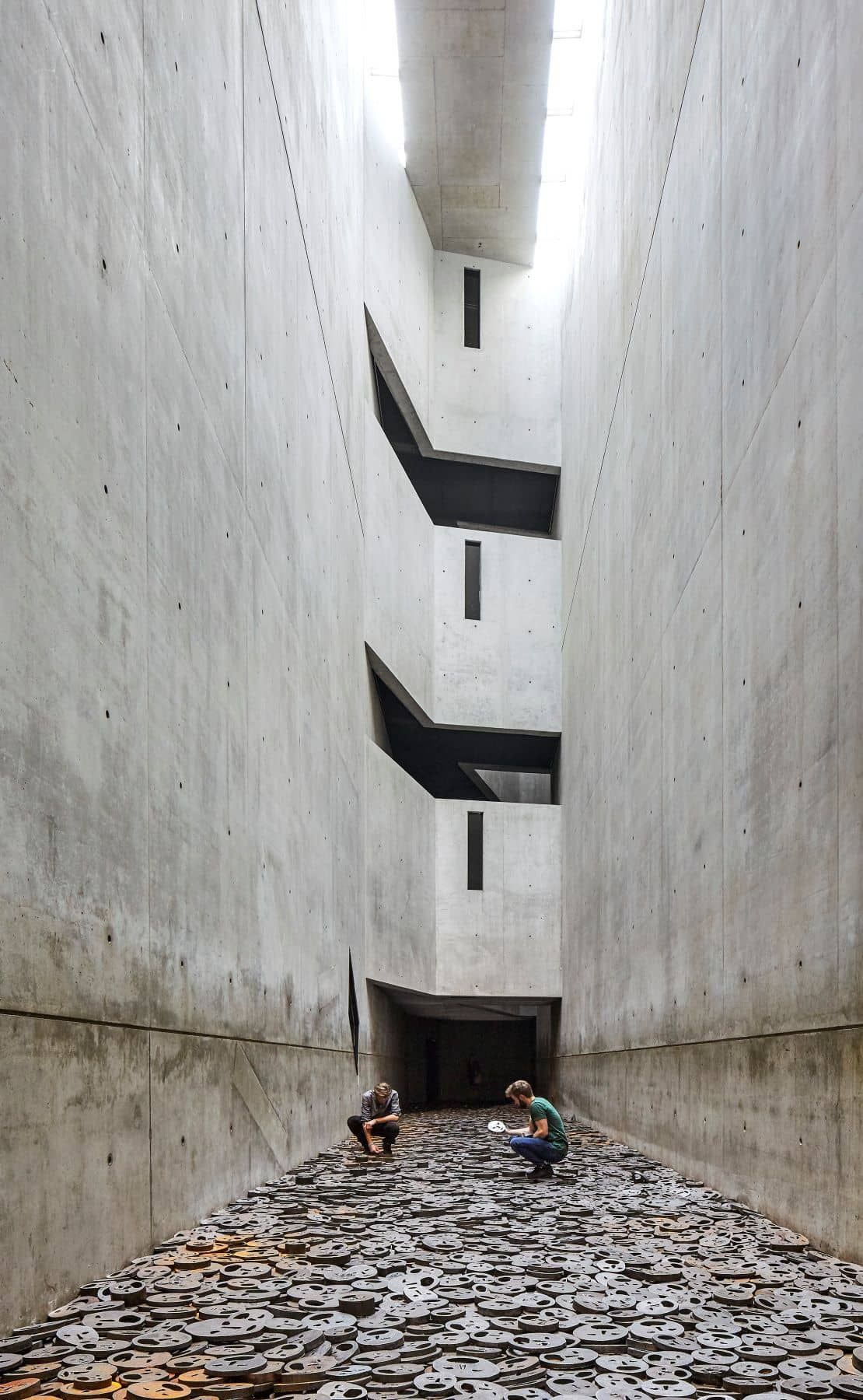
Jewish Museum, Berlin - Faces of Holocaust. From the Architect’s website.
The passion of these endeavors is almost akin to the passion that drives struggles for freedom. These works aim at our base instincts for effect; the primary of which is the emotion of fear, an instinct we share with the other animals, and which has driven us toward the realization of better situations. In the case of intentions such as these, the consequences are imagined. There is a degree of preparedness on part of the creator, a readiness to stop if the experiment is a failure, and to change direction, to re-evaluate. Essentially, a violence of this nature is not damaging on a wide scale (to the disappointment of its perpetrators!) Not so with the environmental brutality cited by Peter Katz, or the brutality of the Holocaust. These latter types are on a large scale, incomparable to Libeskind’s metaphorical violence. And, since these latter types of violence are either not intended consciously, or the effects of those actions is not preconceived, or is purely maniacal, it has results which are often difficult to control or to bring back to normal. While both types of violence are producing a response, there is a difference between them, in the sense that the tools used for generating the first kind of violence are useful functionally even after their purpose has been served. In the case of violence against environment/humanity, the objects causing violence have to be removed—they invite violence onto themselves. Violence as a metaphor is a correcting device, and as reality, is a device to be corrected.
It is pretty easy for philosophy to practice dying, since it leaves such a distant and remote trace. But for architecture to practice it in light of the fullness of its resources of materials and technology — that is difficult.
(…) the one thing that was not erased in all the bombings — and almost everything was — were the streets: the markings of the streets, the curb, only a few centimeters high. Daniel Libeskind
Architecture to the extent that it is an art, is the last art in a primitive state. Dick Higgins
The inattentiveness with which we encounter most things has given birth to the use of violence as metaphor— to shock, to re-awaken the conscious. The need for change is primal. Man’s search for better environments has been guided, like in every other endeavor of his, by a desire for perfection, a utopia. The desperation of tomorrow’s situation forces one to ask again: what is utopia? And, what is the purpose of architecture? The main innovations have been structural—new materials, new methods of construction. According to Higgins, “this is the equivalent in painting of introducing a new shade of alizarin crimson or gilt paint, and continuing to make the same old Secessionist or post-impressionist commodity …The perception of space, the use of space is still quagmired in 19th century or pseudo-Marxist assumptions.” While man has progressed in all his material endeavors, his evolution from a life highly dependent on material things to non-material things —in Entertainment: theatre to virtual reality— has largely left architecture unaffected. While man has changed all things to accommodate himself better, he has had to accommodate architecture: a major failure. The dissatisfaction that this failure prompts expresses through the ‘bravura’ elements in Le Corbusier’s work, or Starck’s ‘emotive products’ and ‘fertile surprises’, or Libeskind’s _ void _. All, as stated earlier, appeal to our basic senses. And in it lies the secret of their success. Richard Sennet in his ‘Flesh and Stone’ says, “Until quite recently, perfectly viable buildings in New York disappeared with the same regularity they appeared. … Even today, with historic controls, new skyscrapers in New York are planned to last fifty years, and financed accordingly, though as engineered objects they could last much longer. Of all the world’s cities, New York has most destroyed itself in order to grow; in a hundred years people will have more tangible evidence about Hadrian’s Rome than they will about fiber-optic New York.”

Berlin Wall - Paving Marker
The “Wall” had to fall. Today, a small physical part of the Wall remains, perhaps as a remainder of the past. Much the same way that Libeskind tries to memorialize the same past. But if we have to move on, the remainder of the Wall will have to be erased too, slowly, to allow for the mind and heart to recuperate. Every visitor to Berlin should take away a piece of the remaining Wall with him, until in the end, none of the physical wound on the city remains, corresponding to the re-attainment of tolerance and humility by its people. Just like the vanquishing of Hitler, it shall be a liberating gift to Berlin from the rest of the world. The wall has to go. And so too, the violence of the void in the museum will one day go. All that will remain will be the curiosity value of its exhibits, as happens with all the museums of medieval art and such like. The museum will stand and close itself off in a different way, just as Libeskind had to straighten the walls of the museum as Berlin was unified.
The task of architecture and art in general is understood to be the reconstruction of the experience of a world in which we are not mere spectators, but to which we inseparably belong. It is clear that the architecture of traditional cultures is essentially connected with the tacit wisdom of the body, instead of being visually and conceptually dominated.
Indigenous clay and mud structures seem to be born of the muscular sense more than the eye. The domination of the sense of vision is evident in the development of Western architecture. Greek architecture, with its elaborate systems of optical corrections, was ultimately refined for the pleasure of the eye.
However, this dominance of the eye does not imply the rejection of the perceptions through the other senses; the unconscious _ tactile _ ingredient in vision is particularly important.
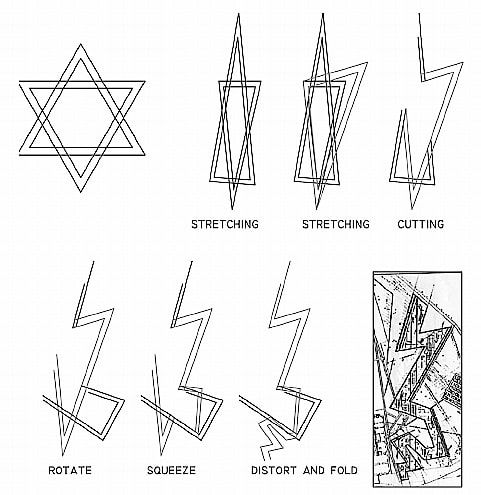
Topological transformation of the Star of David in the plan of Libeskind’s Berlin Museum with the Jewish Museum Department. Drawing by Alessandra Capanna 1
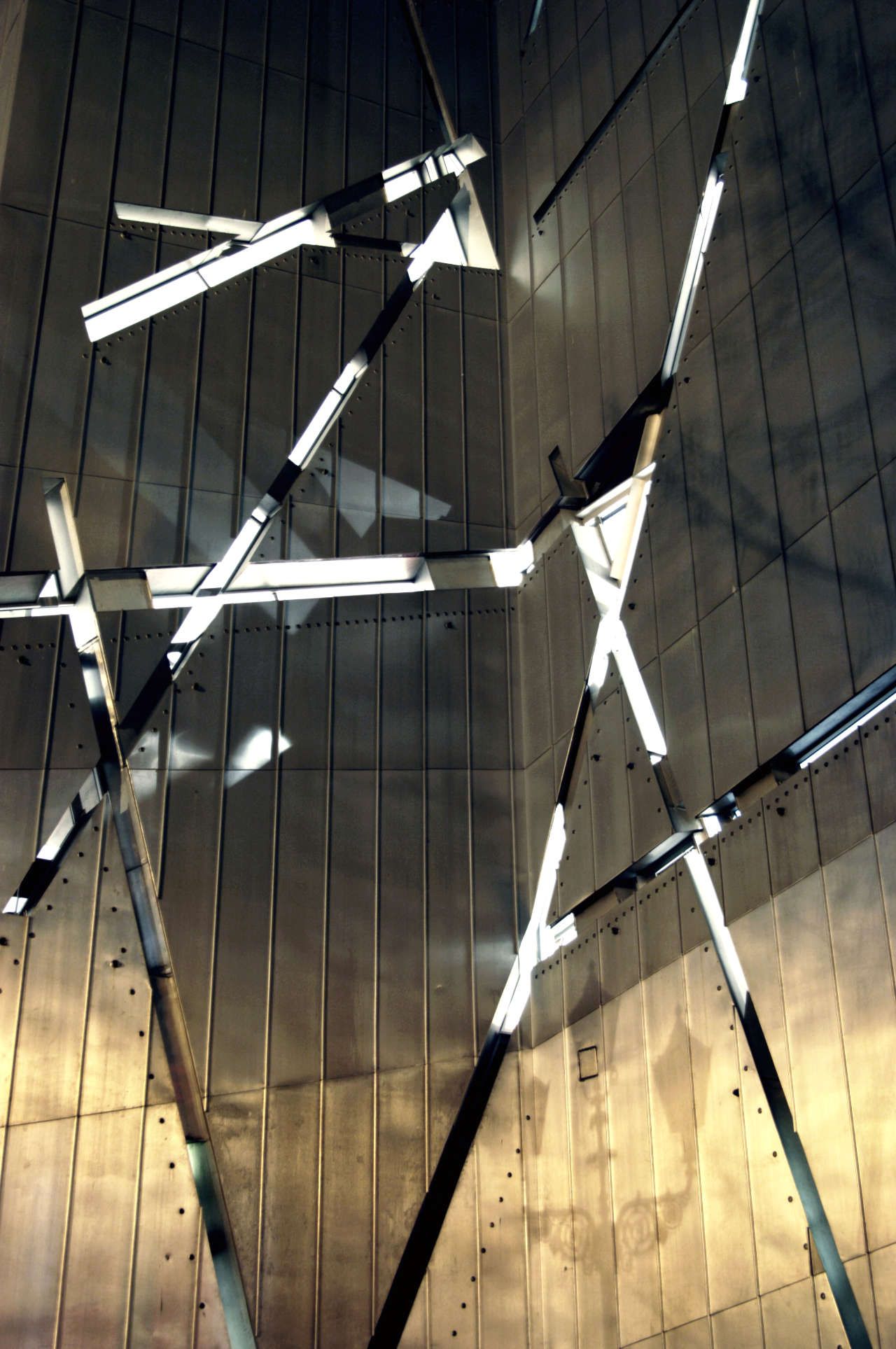
Transformation of the “Star of David” in the elevation of Libeskind’s Jewish Museum. Image from the Architect’s website.
The contemporary city is evermore ‘the city of the eye’, detached from the body by rapid motorized movement. Instead of an existentially grounded plastic and spatial experience, architecture has adopted the psychological strategy of advertising, of persuasion, and buildings have turned into image products detached from existential sincerity.
The dominant sense of vision figures strongly in the writings of early Modernists. Statements by Le Corbusier make the privilege of the eye very clear, such as: “I exist in life only on the condition that I see”; and, “Architecture is a plastic thing, I mean by ‘plastic’ what is seen and measured by the eyes”. Le Corbusier, however, was a great sculptural talent with a moulding hand, and a tremendous sense of materiality and gravity, all of which prevented his architecture from turning into sensory reductivism. A vigorous element of tactility is incorporated into Le Corbusier’s regard for architecture. Nonetheless, this reductive bias becomes clear and devastating in his urbanism projects.
Libeskind’s sense of structure, weight, detail and craft decisively enrich the visual paradigm. Moreover, “an architectural work is great precisely because of the oppositional and contradictory intentions and allusions it succeeds in fusing together. A tension between conscious intentions and unconscious drives is necessary for a work in order to open up the emotional participation of the inhabitant.”2
 How to Select a Topic for a Thesis Dissertation, or a Research Paper
Design as a Business
Is it possible to be a good designer, and still be prosperous? How did business make its way into design? Is it okay for a designer to talk money?
How to Select a Topic for a Thesis Dissertation, or a Research Paper
Design as a Business
Is it possible to be a good designer, and still be prosperous? How did business make its way into design? Is it okay for a designer to talk money?